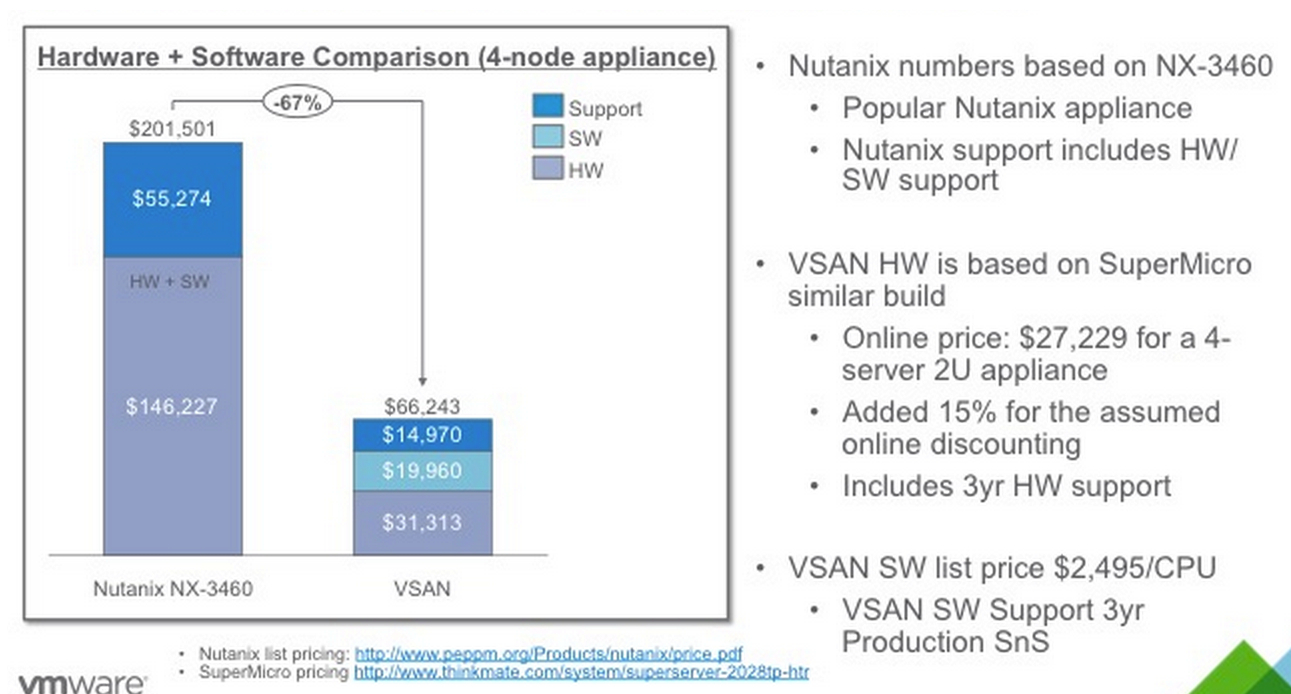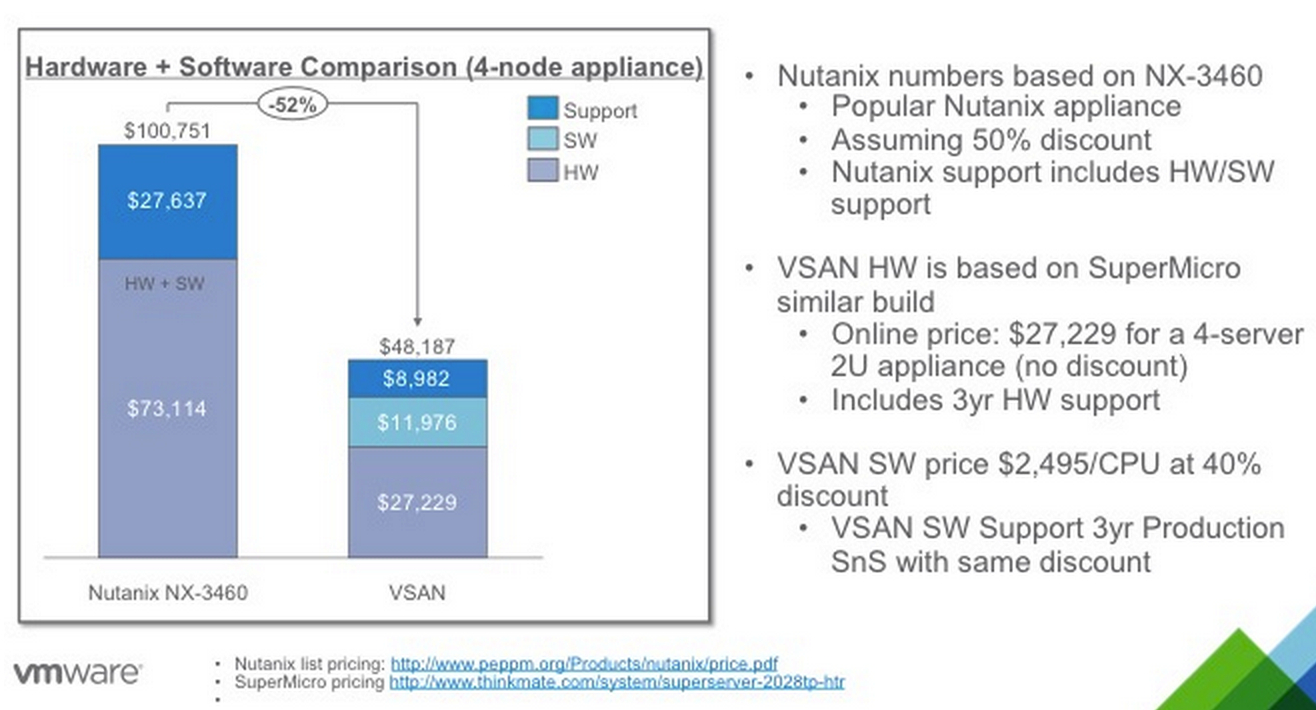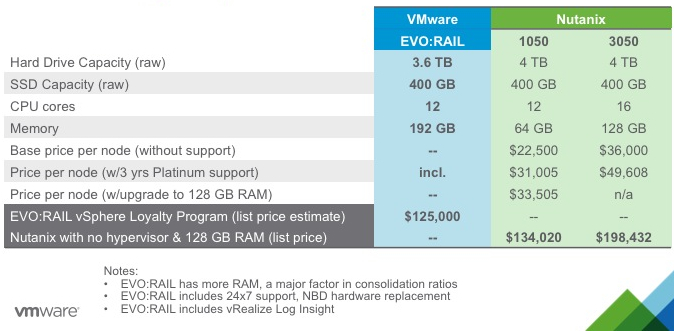VMware VSAN Vs. Nutanix Pricing Comparison – Why Pay More?
By Chuck Hollis, chief strategist, storage and availability, VMware
This is a Press Release edited by StorageNewsletter.com on June 22, 2015 at 2:19 pm
This article was posted on June 5, 2015 on the blog of VMware, Inc. by its Chuck Hollis, chief strategist, storage and availability.
VMware VSAN vs Nutanix Head-To-Head Pricing Comparison – Why Pay More?
When presented a huge differential in acquisition costs for ostensibly similar products, every IT professional inevitably asks the question “why pay more?“
Maybe there’s a good reason for a substantial difference … and maybe not.
We’d like to share with you some preliminary data points we’ve collected around comparative pricing for VMware Virtual SAN and Nutanix.
There’s an important difference in the underlying business models. Nutanix sells a complete, turnkey appliance. VMware VSAN (and vSphere) is software that runs on the customer’s choice of hardware – it’s software-defined storage. Both deliver a hyperconverged solution.
A few caveats before we begin?
In reality, the only prices that matter are the ones that you pay. Portions of the IT industry can be relatively opaque when it comes to finding typical street pricing. Bigger buyers tend to get better prices than smaller buyers. Initial small buys might be priced very competitively if the vendor believes they might lead to larger transactions.
Your mileage may vary – we’ve done our best here!
We’re presenting the data we have, so you can draw your own conclusions.
We have three different examples of head-to-head pricing for you to consider. In each case, we have not included the licensing cost for vSphere itself, as that should be identical for each.
Example 1:
This one comes from publicly available sources.
Let’s compare a four-server NX-3460 ‘G4’ node (a popular model) against configuring similar hardware from their supplier SuperMicro. According to this published price list, the Nutanix NX-3460 appliance lists for $201,501 for hardware, software and three years of support.
As a comparison, we’ve configured our equivalent SuperMicro using web pricing from this site:
- Barebone Supermicro SuperServer 2028TP-HTTR – 2U TwinPro2 – 24x SATA – Dual 10GbE – 2,000W Redundant
- Processor: 8 x Eight-Core Intel Xeon Processor E5-2630 v3 2.40GHz 20MB Cache (85W)
- Memory: 32 x 16GB PC4-17000 2,133MHz DDR4 ECC Registered DIMM
- Boot Drive: No SATA Disk on Module for Boot
- HDD: 16 x 1TB SATA 6.0Gb/s 7,200rpm – 2.5″ – Seagate Constellation.2
- SSD: 8 x 400GB Intel SSD DC S3710 Series 2.5″ SATA 6.0Gb/s SSD
- Optical Drive: No Optical Drive Support
- Network Card: 4 x Intel Ethernet Server Adapter I350-T2V2 Dual Port (2 x RJ-45)
- OS: No Windows OS (Hardware Warranty Only, No Software Support)
- Warranty Three: Year Warranty with Advanced Parts Replacement and NBD Onsite Service
Apologies in advance if we missed something in the configuration, but – as you’ll see in a moment – it won’t make a lot of difference.
VSAN vs. Nutanix Customer List Price Comparison
The SuperMicro hardware-only total comes to $27,229 with three years of 24×7 support with next-business-day hardware replacement.
vSphere will need to be licensed identically for both configurations, so that’s a wash and not included here. VSAN itself carries a list price of $2495 per processor, so that’s $19,960additional for VSAN, three years of SnS (support) is $14,970.
Our like-for-like configuration for VSAN running on SuperMicro now comes to $62,159 as compared to $201,501for Nutanix. That means the VSAN solution is 69% less expensive.
Ah, but we’re comparing against Nutanix list prices, and no one should be paying list these days. We certainly don’t know precisely how Nutanix discounts, but let’s assume an aggressive 50% discount for Nutanix. Just to even things out, let’s also assume a theoretical 40% discount for VSAN.
VSAN vs. Nutanix Customer Street Price Comparison
Heavily discounted, the Nutanix package now comes to $100,751.The equivalent VSAN/SuperMicro package (without hardware discounting) comes to $48,187. Obviously, a huge premium. I would additionally argue that the VSAN/SuperMicro package would offer considerably more performance, as well as a superior day-to-day management experience.
When software is decoupled from hardware, customers win.
Example #2
Dell now sells their version of Nutanix. Recently, one of our teams investigated acquiring two configurations – one to run Nutanix, one to run VSAN, everything the same. Dell pricing is somewhat different than Nutanix pricing, but there’s still a meaningful difference.
The quoted price for the Dell/Nutanix configuration was $214,855.
The price for the bare-bones equivalent Dell configuration was$46,911. To even things up, you’d have to license VSAN for 8 CPUs in this case, so add (list) $19,960 for that – so a new total of$66,871 for VSAN on Dell vs. $214,855 for the Dell/Nutanix.
The only missing pricing component on the VSAN/Dell side is three years of hardware support. But still, a $147,984 difference for a four-server appliance?
Again, I would personally argue that the VSAN/Dell solution would offer much greater performance, and a superior day-to-day operational experience.
Full details of our received quote can be found here: Dell-VSAN vs Dell-Nutanix-Price-Quoteshttp://blogs.vmware.com/storage/files/2015/06/Dell-VSAN-vs-Dell-Nutanix-Price-Quotes.pdf
Again, when software is decoupled from hardware, customers win.
Example #3
This one involves EVO:RAIL – which uses VSAN. Like Nutanix, EVO:RAIL is an all-in-one appliance that delivers a simplified out-of-the-box experience. Keep in mind, actual prices are determined by our EVO:RAIL partners, so we’re presenting list price estimates. The deltas are less compelling, but they’re still significant.
To get a more even apples-to-apples comparison, we have to do some adjusting.
For the Nutanix 1050, we had to add RAM to get to 128GB vs. 192GB on the EVO:RAIL. We had to add Nutanix Platinum Support to reach equivalency to the EVO:RAIL 24×7 support with NBD parts replacement.
EVO:RAIL is now available with the vSphere Loyalty Program, which means that – for both solutions – bring your own vSphere licenses.
4-Node Pricing Example: EVO-RAIL and Nutanix
Compared to the Nutanix 1050, the EVO:RAIL is ~$10K less expensive, and the EVO:RAIL includes 64GB of additional RAM. Not as large a delta as previous examples, as this is a very price-sensitive portion of the marketplace.
But move up to the next model, and the picture changes. Compared to the Nutanix 3050, the EVO:RAIL is $73,432 less expensive. Note that the Nutanix has four additional cores (as well as 64GB less RAM) as compared to the current EVO:RAIL
Although we can’t get precisely to apples-to-apples (can’t seem to get to precisely 192GB of RAM on the Nutanix boxes), it illustrates my point.
My Conclusions
Customers can win when they have the flexibility to source their hardware and software independently if they choose. This illustrates the powerful economics of true software-defined storage.
Based on the research above, Nutanix appears to be charging a very hefty premium for largely equivalent configurations. Even with aggressive discounting, there’s a vast gulf in relative pricing.
In all fairness, Nutanix will likely point to the ‘value’ of their solution. But I’d argue back that ‘value’ is entirely in the eyes of the beholder. Both solutions deliver simple, hyperconverged functionality.
Where might the value come from?
If we factor in the relative performance of each (a work in progress, admittedly), the per-VM cost differentials will likely become even *more* extreme. And that’s *before* we get to the other advantages of the VSAN approach: technical advantages, operational advantages and more.
Why pay more?













 Subscribe to our free daily newsletter
Subscribe to our free daily newsletter
